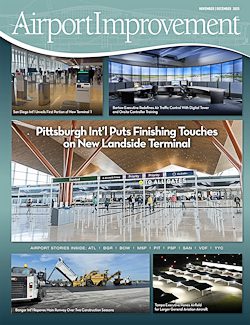
|
General Mitchell |
“Markings are ‘the other navigation aid,'” remarks Terry Blue, deputy airport director, operations and
maintenance. “They play a huge role in maintaining safety.”
While Blue believed the airport could make its pavement markings program more efficient, he needed expert information and advice. To that end, MKE hired airport marking consultant Sightline, LC for $19,500 to perform an airfield marking audit – the first at any U.S. airport.
|
Facts & Figures Project: Airfield Marking Audit Location: General Mitchell International Airport Milwaukee, WI Consultant: Sightline, LC Cost: $19,500 Goals: Improve airfield safety; improve application efficiency |
While airport markings must pass Federal Aviation Administration (FAA) inspection, Speidel notes that FAA inspectors generally do not evaluate markings the same way Sightline does: “They see the what, where and when of the markings,” she says. “We evaluate how effective they are as a visual aid, including their nighttime appearance. With training, inspectors become more observant of marking quality.”
Terry Blue
Marking Condition Index

In October 2009, two Sightline technicians spent approximately one week evaluating the condition of pavement markings on MKE’s taxiways and five runways during daylight and nighttime conditions. The data collected from the audit was analyzed and presented in a marking condition index (MCI) report that summarized the condition of the markings as well as the condition of the pavement underneath.
Alignment of the markings, adhesion of markings to pavement, daytime and nighttime color and reflectivity, and compliance of markings with FAA standards were evaluated and addressed. The report identified areas in need of immediate attention, recommended surface preparation techniques and evaluated the airport’s equipment and application methods.
|
Donna Speidel |
Spending Money to Save Money
MKE maintenance staff currently use five walk-behind paint applicators and separate glass bead dispensers to produce markings for five runways and adjacent taxiways – approximately 450 acres of pavement. Markings are applied at least once a year and in some places twice a year.
The audit found that in addition to adding tremendous costs in labor and time, MKE’s current equipment applies paint and glass beads inefficiently. To maintain proper reflectivity and adhesiveness, approximately 50% of the spherical glass beads must be imbedded into the paint. Paint must also be applied at specific thickness levels and beads applied immediately to ensure proper adhesion.
 “Sightline gave us a baseline for our markings and offered suggestions on how we could improve reflectivity and make our markings last longer,” Blue says. “They recommend a one-step process for applying beads, which requires new equipment. We have great equipment for doing smaller jobs, but we need more capacity for doing an entire airport.”
“Sightline gave us a baseline for our markings and offered suggestions on how we could improve reflectivity and make our markings last longer,” Blue says. “They recommend a one-step process for applying beads, which requires new equipment. We have great equipment for doing smaller jobs, but we need more capacity for doing an entire airport.”
Sightline provided the airport with a list of equipment options and cost projections based on labor time, square footage of application area and application rate. Using 2008 and 2009 pavement marking costs as a baseline, cost projections for Sightline’s recommendations through 2013 spike in 2010 as a result of equipment purchases, then fall below the 2009 level by 2013.
 “Eventually, we’re going to get to the point where we’re using less paint, fewer beads and ideally, in some places, painting only once a year instead of twice a year,” Blue explains. “While our near future expenditures will be going up, over time they will decrease significantly.”
“Eventually, we’re going to get to the point where we’re using less paint, fewer beads and ideally, in some places, painting only once a year instead of twice a year,” Blue explains. “While our near future expenditures will be going up, over time they will decrease significantly.”
Moving Forward
Applying and maintaining airfield markings isn’t rocket science, but doing it correctly and efficiently requires proper training and tools.
 According to Speidel, many airport crews apply paint with trucks moving at 14 or 15 miles an hour. This yields a thin coating, she says; and when the beads hit the paint, they don’t imbed and the markings soon prove to be dysfunctional.
According to Speidel, many airport crews apply paint with trucks moving at 14 or 15 miles an hour. This yields a thin coating, she says; and when the beads hit the paint, they don’t imbed and the markings soon prove to be dysfunctional.
She advocates a different approach: “Prepare the surface, use good materials, use proper application equipment and techniques, and inspect the product. You can spend a lot of money and a lot of time maintaining your markings, but if they aren’t maintained properly, you’re not getting your money’s worth.”
 |  |

“If you’re going to provide the tools, you have to provide the know-how as well,” he says. “We plan on implementing annual or biannual training. We can bring in Sightline or perhaps send staff to seminars or tech schools for further training.”
MKE plans to begin following Sightline’s recommendations in 2010 using funds set aside in the airport’s operating budget.
“We’re anxious to implement the recommendations,” Blue says. “Markings are out there for a reason – to improve safety. With regard to efficiency, we not only want to keep our airport moving forward, we also want to get the best bang for our buck.”




